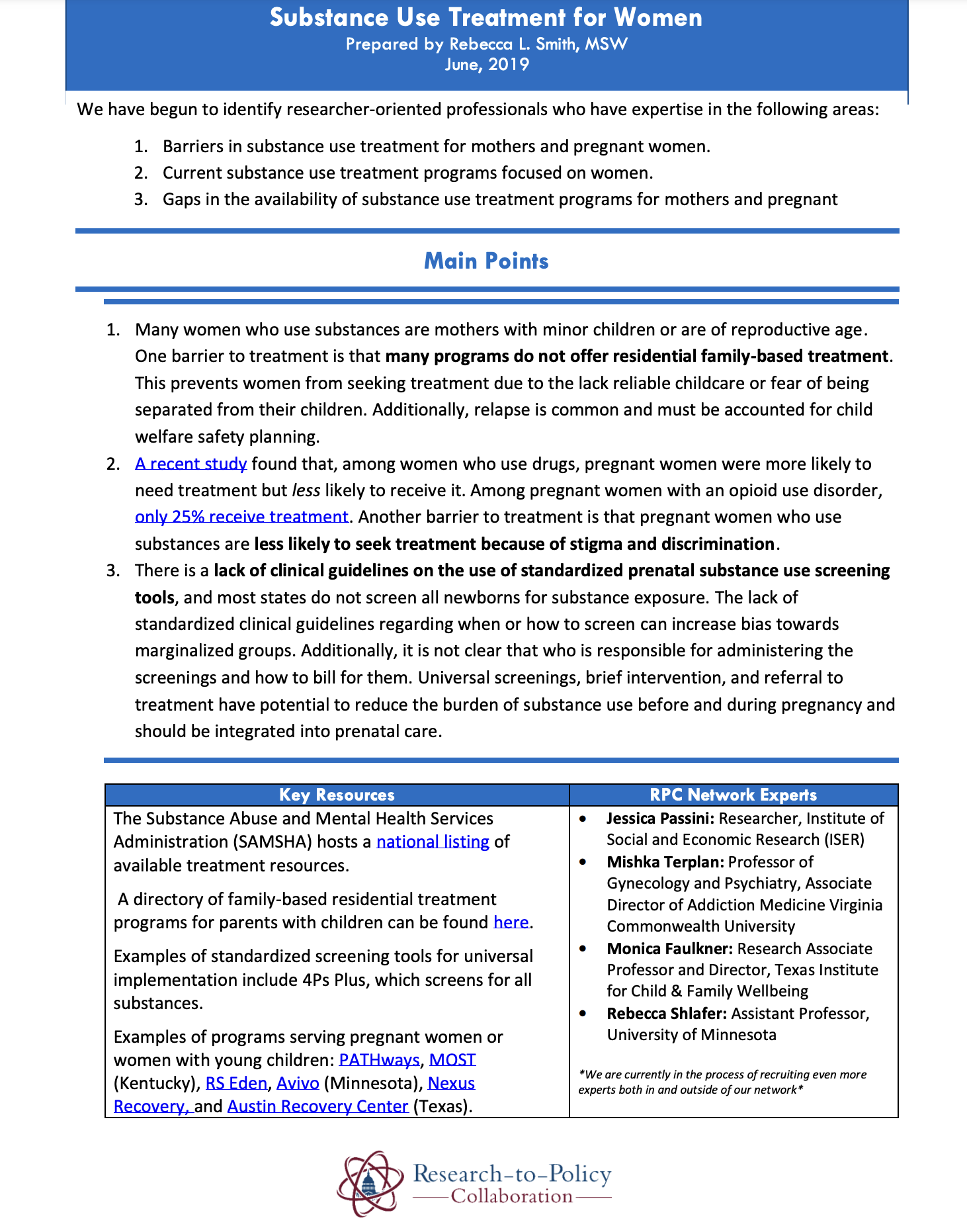
We have begun to identify research-oriented professionals who have expertise in the following areas:
- Barriers in substance use treatment for mothers and pregnant women.
- Current substance use treatment programs focused on women.
- Gaps in the availability of substance use treatment programs for mothers and pregnant.
Main Points
- Many women who use substances are mothers with minor children or are of reproductive age. One barrier to treatment is that many programs do not offer residential family-based treatment. This prevents women from seeking treatment due to the lack of reliable childcare or fear of being separated from their children. Additionally, relapse is common and must be accounted for child welfare planning.
- A recent study found that, among women who use drugs, pregnant women were more likely to need treatment but less likely to receive it. Among pregnant women with an opioid use disorder, only 25% receive treatment. Another barrier to treatment is that pregnant women who use substances are less likely to seek treatment because of stigma and discrimination.
- There is a lack of clinical guidelines on the use of standardized prenatal substance use screening tools, and most states do not screen all newborns for substance exposure. The lack of standardized clinical guidelines regarding when or how to screen can increase bias towards marginalized groups. Additionally, it is not clear that who is responsible for administering the screenings and how to bill them. Universal screenings, brief intervention, and referral to treatment have potential to reduce the burden of substance use before and during pregnancy and should be integrated into prenatal care.
Key Resources
- The Substance Abuse and Mental Health Services Administration (SAMSHA) hosts a national listing of available treatment resources.
- A directory of family-based residential treatment programs for parents with children can be found here.
- Examples of standardized screening tools for universal implementation include 4Ps Plus, which screens for all substances.
- Examples of programs serving pregnant women with young children: PATHways, MOST (Kentucky), RS Eden, Avivo (Minnesota), Nexus Recovery, and Austin Recovery Center (Texas).
The Research-to-Policy Collaboration (RPC) works to bring together research professionals and public officials to support evidence-based policy. Please visit their website to learn more.
Key Information
RPC Website
Research-to-Policy Collaboration
More RPC Resources
RPC Resources
Publication DateJune 1, 2019
Topic Area(s)Community-Specific, Substance Use and Misuse
Resource TypeWritten Briefs
Share This Page
We have begun to identify research-oriented professionals who have expertise in the following areas:
- Barriers in substance use treatment for mothers and pregnant women.
- Current substance use treatment programs focused on women.
- Gaps in the availability of substance use treatment programs for mothers and pregnant.
Main Points
- Many women who use substances are mothers with minor children or are of reproductive age. One barrier to treatment is that many programs do not offer residential family-based treatment. This prevents women from seeking treatment due to the lack of reliable childcare or fear of being separated from their children. Additionally, relapse is common and must be accounted for child welfare planning.
- A recent study found that, among women who use drugs, pregnant women were more likely to need treatment but less likely to receive it. Among pregnant women with an opioid use disorder, only 25% receive treatment. Another barrier to treatment is that pregnant women who use substances are less likely to seek treatment because of stigma and discrimination.
- There is a lack of clinical guidelines on the use of standardized prenatal substance use screening tools, and most states do not screen all newborns for substance exposure. The lack of standardized clinical guidelines regarding when or how to screen can increase bias towards marginalized groups. Additionally, it is not clear that who is responsible for administering the screenings and how to bill them. Universal screenings, brief intervention, and referral to treatment have potential to reduce the burden of substance use before and during pregnancy and should be integrated into prenatal care.
Key Resources
- The Substance Abuse and Mental Health Services Administration (SAMSHA) hosts a national listing of available treatment resources.
- A directory of family-based residential treatment programs for parents with children can be found here.
- Examples of standardized screening tools for universal implementation include 4Ps Plus, which screens for all substances.
- Examples of programs serving pregnant women with young children: PATHways, MOST (Kentucky), RS Eden, Avivo (Minnesota), Nexus Recovery, and Austin Recovery Center (Texas).
The Research-to-Policy Collaboration (RPC) works to bring together research professionals and public officials to support evidence-based policy. Please visit their website to learn more.

Key Information
RPC Website
Research-to-Policy Collaboration
More RPC Resources
RPC Resources
Publication DateJune 1, 2019
Topic Area(s)Community-Specific, Substance Use and Misuse
Resource TypeWritten Briefs
Share This Page
LET’S STAY IN TOUCH
Join the Evidence-to-Impact Mailing List
Keep up to date with the latest resources, events, and news from the EIC.




